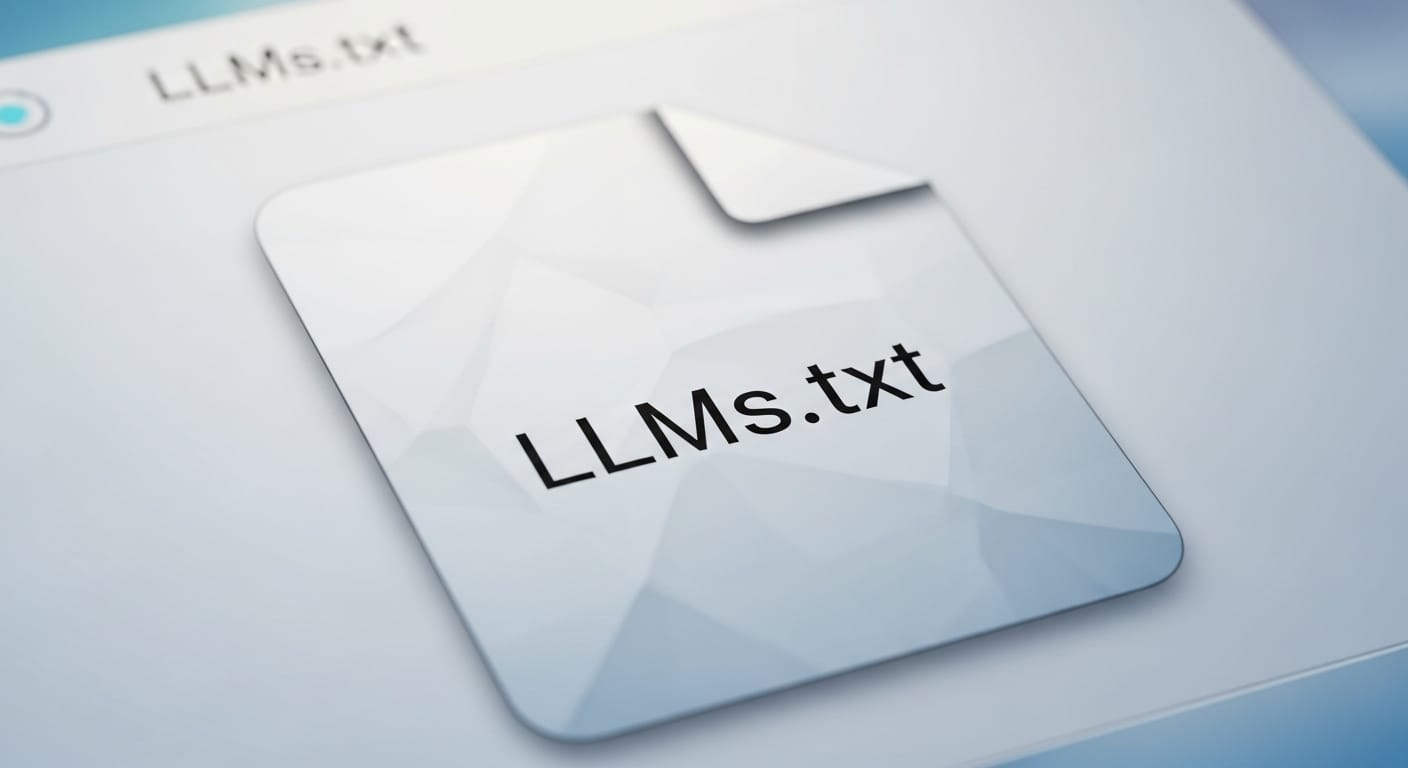- Amu M
- 0 Comments
- 13 Views
Artificial intelligence is no longer a futuristic buzzword—it’s here, shaping the way we search, learn, and even create. Behind many of today’s most powerful AI systems are large language models (LLMs) like OpenAI’s GPT, Google’s Gemini, and Anthropic’s Claude. These systems are trained on vast amounts of online content.
But this raises an important question: How can website owners, publishers, and businesses control how their content is used in AI training?
Enter LLMs.txt—a new standard designed to give website owners more transparency and control over the relationship between their content and large language models.
In this article, we’ll cover everything you need to know about LLMs.txt, including:
What LLMs.txt actually is (in plain English)
How it works compared to robots.txt
Why it benefits website owners, content creators, and AI companies alike
Practical steps to implement it on your website
Its role in the future of responsible AI and SEO
Let’s dive in.
What Is LLMs.txt?
At its core, LLMs.txt is a machine-readable text file that website owners can place on their server to signal permissions or restrictions about how AI companies can use their content to train large language models.
Think of it as the robots.txt for AI training.
Where robots.txt tells search engine crawlers (like Googlebot or Bingbot) what they can or can’t index, LLMs.txt tells AI crawlers whether their content can be:
Accessed by AI scrapers
Used in training datasets
Shared with third parties
For example, a website might allow Google’s search crawler to index its pages but block OpenAI from training on its articles. Conversely, a publisher might choose to allow AI systems to access older archived content but block premium or paywalled material.
This gives content owners agency in the evolving world of generative AI.
Why Do We Need LLMs.txt?
The rise of LLMs has brought unprecedented opportunities—but also new challenges.
1. Content ownership and consent
Without controls, AI models may ingest content without explicit permission. This raises ethical and legal concerns, especially for businesses that invest heavily in original content.
LLMs.txt ensures content creators can say: “Yes, you may use this”—or “No, you may not.”
2. Transparency in AI training
AI companies often train on web-scale datasets—trillions of tokens pulled from millions of websites. But until recently, website owners had little visibility into whether their work was part of that data.
LLMs.txt makes the process more transparent and accountable.
3. Protecting business value
For publishers, e-commerce stores, educators, and SaaS companies, content isn’t just information—it’s intellectual property that drives revenue. Allowing unrestricted AI scraping could dilute that value.
LLMs.txt helps safeguard digital assets while still leaving the door open for mutually beneficial partnerships.
How Does LLMs.txt Work?
LLMs.txt follows a simple format similar to robots.txt.
The file is named
llms.txtIt lives at the root of your website (e.g.,
https://example.com/llms.txt)It contains directives that allow or disallow specific AI agents
Here’s a basic example:
User-Agent: GPTBot Disallow: /premium/ Allow: /blog/ User-Agent: ClaudeBot Disallow: / Explanation:
GPTBot (OpenAI’s crawler) can use your blog content but not your premium section.
ClaudeBot (Anthropic’s crawler) is completely blocked from using any of your site’s content.
Much like robots.txt, it’s not a legal enforcement mechanism—but it provides a standardized communication channel between website owners and AI systems.
The Benefits of LLMs.txt
1. Control Over AI Training
LLMs.txt gives website owners granular control over what data is used to train AI. This protects sensitive information and ensures that only content you approve gets into training datasets.
2. Preserving SEO Value
Some publishers worry that allowing AI training could cannibalize traffic (e.g., users getting answers directly from AI without clicking through). With LLMs.txt, you can balance SEO visibility and AI exposure by selectively granting access.
3. Protecting Monetized Content
If you run a subscription model, you can block AI scrapers from using paywalled or members-only content. This keeps premium information exclusive to paying users.
4. Encouraging Fair Use Partnerships
AI companies are increasingly open to licensing deals with publishers (e.g., OpenAI’s partnerships with news organizations). By using LLMs.txt, businesses can signal willingness to negotiate rather than being automatically scraped.
5. Building Trust with Audiences
Transparency matters. Visitors will feel reassured knowing you actively manage how your content is shared in the AI ecosystem. This enhances brand credibility and demonstrates forward-thinking stewardship.
LLMs.txt vs. Robots.txt: What’s the Difference?
While the two look similar, their purposes are distinct:
| Feature | Robots.txt (SEO Crawlers) | LLMs.txt (AI Crawlers) |
|---|---|---|
| Primary Purpose | Controls search indexing | Controls AI training |
| Audience | Googlebot, Bingbot, etc. | GPTBot, ClaudeBot, etc. |
| Impact | SEO visibility, rankings | AI datasets, model behavior |
| Typical Use Case | Exclude staging sites, block duplicate pages | Protect paywalled content, allow public blog posts |
The key takeaway: robots.txt is about search visibility, LLMs.txt is about AI consent.
How to Implement LLMs.txt on Your Website
Here’s a practical step-by-step guide:
Identify AI crawlers you want to allow or block. (Examples: GPTBot, ClaudeBot, CCBot from Common Crawl.)
Create a plain text file named
llms.txt.Write directives (Allow/Disallow) for each bot.
Upload the file to the root of your domain.
Test and verify using AI companies’ crawler documentation.
For example, OpenAI provides a page explaining how GPTBot respects LLMs.txt directives.
Real-World Scenarios Where LLMs.txt Helps
1. News Publishers
A newspaper might allow Googlebot to index articles but block GPTBot from scraping its archive, reserving that for paid licensing deals.
2. E-commerce Stores
A store might block AI crawlers from product pricing pages (to prevent mass aggregation) while allowing them to use blog tutorials as a branding play.
3. Educational Platforms
An online course provider might disallow access to course lessons but allow open access to free resources, driving both fairness and brand awareness.
Criticisms and Limitations of LLMs.txt
Like any new standard, LLMs.txt isn’t perfect.
Voluntary compliance: Just like robots.txt, bad actors may ignore it.
No legal enforcement: It’s a guideline, not a law.
Fragmentation risk: Different AI companies may interpret directives differently.
Limited awareness: Many website owners still don’t know it exists.
Despite these challenges, it represents a step in the right direction for balancing innovation and responsibility.
The Future of LLMs.txt and Responsible AI
Looking ahead, LLMs.txt could become a cornerstone of AI governance.
Standardization: More AI companies adopting it could make it an industry-wide norm.
Integration with licensing: Platforms could use LLMs.txt as a negotiation signal for partnerships.
Hybrid use with metadata: Combined with structured data, it may evolve into a more nuanced permission system.
Ultimately, LLMs.txt reflects a growing recognition: the web belongs to its creators as much as it does to its consumers.
Final Thoughts: Why You Should Care About LLMs.txt
The world of AI is moving fast. For businesses, publishers, and creators, the choice is clear: either passively let AI scrape your work—or actively set the terms.
LLMs.txt is a simple, powerful tool to:
Protect your intellectual property
Guide the future of AI responsibly
Balance visibility with consent
Open doors for new revenue opportunities
Whether you run a personal blog, an e-commerce empire, or a global media company, adding an LLMs.txt file today ensures your voice is heard in the AI era.



